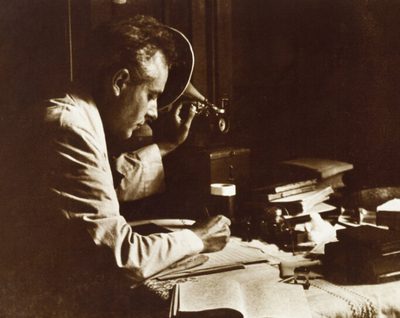
Bach & Bartók
Bach & Bartók
Budapest Festival Orchestra return to the Festival with a programme that celebrates their Hungarian heritage and showcases the vibrancy of music written for dance.
The Budapest Festival Orchestra and polymath founder-conductor Iván Fischer make a welcome return to Edinburgh after their popular 2023 performances. This programme pulses with the vibrant contrasts of dance – from the elegance of Baroque to the raw energy of modern ballet.
Johann Sebastian Bach's Orchestral Suite No.4 is an irresistibly lively take on a standard courtly form. Fischer echoes that sense of experiment in his own 21st-century Dance Suite for Violin and Orchestra, a Bach tribute that dances from bossa nova to ragtime, tango to boogie-woogie.
Béla Bartók's dramatic music for the 'pantomime grotesque' ballet, The Miraculous Mandarin was banned for 'moral filth' on its premiere in 1926. Based on the Hungarian writer Melchior Lengyel's shocking 1916 short story, the score lived on in an orchestral suite, shorn of its most controversial sections.
As a conductor, Iván Fischer, inspirational founder of the Budapest Festival Orchestra, has never hesitated to wear his heart on his sleeve, or to encourage his musicians to do likewise.
Listen on Soundcloud or Spotify.
Supported by James and Morag Anderson
Programme
A keepsake freesheet is available at the venue for this performance.
Full programme
Bach Orchestral Suite No.4 in D, BWV 1069 (1725)
20minsI. Ouverture
II. Bourrée I
III. Bourrée II
IV. Gavotte
V. Menuett I
VI. Menuett II
VII. Réjouissance
Iván Fischer Dance Suite for Violin and Orchestra, in memory of JS Bach (2024)
19minsI. Prelude
II. Bossa nova
III. Rag time
IV. Tango
V. Boogie woogie
UK PREMIERE
Bartók The Miraculous Mandarin, Op.19, Sz.73 (ballet) (1918–24)
33minsI. Allegro: Introduction
II. Moderato: First Decoy Game
III. Second Decoy Game
IV. Sostenuto: Third Decoy Game
V. Maestoso: The Mandarin Enters
VI. Allegro: The Girl Sinks Down to Embrace Him
VII. Sempre Vivo: The Tramps Leap Out
VIII. Adagio: Suddenly the Mandarin's Head Appears
IX. Agitato: Again, the Frightened Tramps Discuss How To Eliminate the Mandarin
X. Molto Moderato: The Body of the Mandarin Begins to Glow With a Greenish Blue Light
XI. Più Mosso: The Mandarin Falls On the Floor
Performers
CloseOpen
- Budapest Festival Orchestra
- Iván FischerConductor
- Guy BraunsteinViolin
Budapest Festival OrchestraCloseOpen
- ConductorIván Fischer
- 1st ViolinGuy Braunstein
Violetta Eckhardt
Ágnes Biró
Balázs Bujtor
Csaba Czenke
Mária Gál-Tamási
Emese Gulyás
Erika Illési
István Kádár
Péter Kostyál
Eszter Lesták Bedő
Gyöngyvér Oláh
János Pilz
Davide Dalpiaz - 2nd ViolinTímea Iván
Antónia Bodó
Solvejg Wilding
Pál Jász
Zsófia Lezsák
Noémi Molnár
Anikó Mózes
Levente Szaboó
Zsolt Szefcsik
Zsuzsanna Szlávik
Zoltán Tuska
Erika Kovács - ViolaCsaba Gálfi
Zoltán Fekete
Barna Juhász
Nikoletta Reinhardt
Nao Yamamoto
Cecília Bodolai
Krisztina Haják
Gábor Sipos
Zita Zarbók
Salomé Osca - CelloPéter Szabó
Éva Eckhardt
Lajos Dvorák
György Kertész
Gabriella Liptai
Kousay Mahdi
Orsolya Mód
Rita Sovány - Double BassZSolt Fejérvári
Attila Martos
Károly Kaszás
László Lévai
Csaba Sipos
Uxia Martinez Botana - FluteGabriella Pivon
Anett Jóföldi
Bernadett Nagy - OboeDudu Carmel
Eva Neuszerova
Marie-Noëlle Perreau
Michele Antonello
Andrea Mion
Elisabeth Passot - ClarinetÁkos Ács
Roland Csalló
Rudolf Szitka - BassoonAndrea Bressan
Dániel Tallián
Bálint Vértesi - HornZoltán Szőke
András Szabó
Máté Harangozó
Zsombor Nagy - TrumpetGergely Csikota
Tamás Póti
Zsolt Czeglédi
Mark Bennett - TromboneBalázs Szakszon
Attila Sztán
Gergely Janák - TubaJózsef Bazsinka
- TimpaniRoland Dénes
- PercussionLászló Herboly
István Kurcsák
Kornél Hencz
Ádám Maros
Nándor Weisz - HarpÁgnes Polónyi
- Celesta / Organ / Piano / Electric Piano / HarpsichordEmese Mali
László Adrián Nagy
Dóra Pétery
Dive Deeper
Listen to The Warm Up: your audio introduction to the performance.
Programme Note

By Sarah Urwin Jones
Sarah Urwin Jones is a writer, editor and translator specialising in Classical Music and Opera. She has written on music for The Times, The Independent and BBC Music Magazine amongst others and writes programme notes for a number of orchestras and opera houses.
Bach, Bartók and the Echoes of Dance
French culture was all the rage in early 18th-century Germany, inspired by the dazzling works of Jean Baptiste Lully, court composer to the dance-mad ‘Sun King’, Louis XIV at Versailles. Lully frequently contrived instrumental dance suites as court entertainment, using the overtures and ballet interludes from his operas. The music filtered quickly to Germany, where composers were keen to imitate the French style.
Orchestral Suite No.4 in D, Johann Sebastian Bach
Johann Sebastian Bach (1685-1750) developed the genre in his four Orchestral Suites (‘Ouvertures’), most likely composed between 1717, when he was working at the Cöthen court of Prince Leopold, north of Leipzig, and 1739, during his long tenure in Leipzig itself. The Orchestral Suite No 4, likely the first composed (the suites were numbered in the 20th Century), was probably compiled from earlier works rewritten for Leipzig’s Collegium Musicum.
Orchestrated for strings, harpsichord, wind (oboes and bassoon), trumpet and timpani (likely to be additions in a later version), it has the fullest orchestra of the four suites. The virtuosic writing, which vividly evokes dance movement, combines the refined ‘French’ form with elements of what Germans saw as the more ‘passionate’ Italian style.
The Overture has a sparkling instrumental back-and-forth, a dialogue which Bach reworked for his (Christmas) Cantata BWV 110 some years later. Three French dances follow: a Bourrée (a lively character piece that reflects the jumps in the dance itself), a Gavotte (vivid and inspired by folk dance) and a Minuet (reflecting the courtly version of a southern French folk dance). The finale is the doubly infectious Réjouissance, which is both highly complex, playing with rhythms and meter, and virtuosic.

Johann Sebastian Bach (1685–1750), German Composer
© Stefano Bianchetti / Bridgeman ImagesDance Suite, Ivan Fischer
Some few centuries later, Ivan Fischer’s Dance Suite, reverentially ascribed ‘in piam memoriam Bach’, was written by the Budapest Festival Orchestra Music Director after finding himself imagining the nostalgic feelings an elderly contemporary of Bach might have felt listening to the Orchestral suites with their references to French dances that were popular ‘in the previous generation’. It led Fischer to compose a suite ‘after’ Bach, comprising ‘a sequence of dances for which...people now may have the same type of nostalgia’.

Ivan Fischer (1951–present)
The Prelude opens with a Bachian yet freeform cadenza, the orchestra entering in somber mood, segueing into an off kilter waltz, before returning to the sombre solo theme. The first of the four dance movements proper is a Bossa Nova, lightening the mood before an infectious Ragtime, led by the flute and continued slightly off-key in the violin. The Tango is again flute-led, a hazy evocation of tango rhythms that dissipates as if in a dream. By way of finale – a modern-day reflection of Bach’s Réjouissance - a rambunctious Boogie-Woogie zips along with an ever-increasing roster of toe-tapping musicians.
TheMiraculous Mandarin, Béla Bartók
Dance of a different ilk in Béla Bartók’s one-act ‘grotesque pantomime’ The Miraculous Mandarin, controversial in his time and with a brutal plot that still shocks. Composed in 1918-1919, and orchestrated in 1924 to a story by Melchior Lengyel (who also penned Hollywood comedies), it is a gritty, sordid tale of a woman held hostage by three tramps and forced to lure men in to a room for the three to rob.
Written at a time of hardship and political upheaval in Hungary, not to mention a dose of Spanish Flu, Bartók’s thrillingly visceral music, with its violent rhythms and erotic undertones, charts a path in 12 sections from seduction to robbery and murder. When the ballet premiered to scandalised uproar in Cologne in 1926, the mayor banned further performances. But Bartók felt it a masterpiece.

Bela Bartok (1881–1945), Hungarian composer
© NPL - DeA Picture Library / Bridgeman ImagesComposed on the cusp of Bartók’s flirtation with atonality, each character is described in distinctive musical terms. The first two men that the woman (represented by the clarinet) lures in from the street are penniless – a shambling old man and a shy young man, and the robbers throw them out, represented in the score with thuggish staccato in the brass.
The third victim is the ‘Miraculous Mandarin’, chiming with a societal fascination with the East. Bartók used his knowledge of various Eastern tonalities to musically define the Mandarin. His entrance is marked with terrifying, almost supernatural grandeur in the orchestra, his instruments trombones, cymbals and drums. The woman is frightened by the Mandarin’s stare – the tentative music shows he too is unsure of the situation - but the robbers force her to dance for him. Overcome with passion, marked with increasing frenzy in the orchestra, the Mandarin chases the horrified woman. When he catches her, the men rob him and try to kill him, first by suffocating him, then running him through with an old sword, then hanging him from the light fitting.
But no matter what violence they inflict, he will not die, rising repeatedly towards the woman. After falling limp to the floor, he begins to glow a strange greenish-blue (marked with eerie moans from the chorus). The woman motions to the terrified men to set him free, and allows him to embrace her. Having done this, he dies, a symbol of the power of human passion, to juddering strains in the orchestra.
© Sarah Urwin Jones 2025